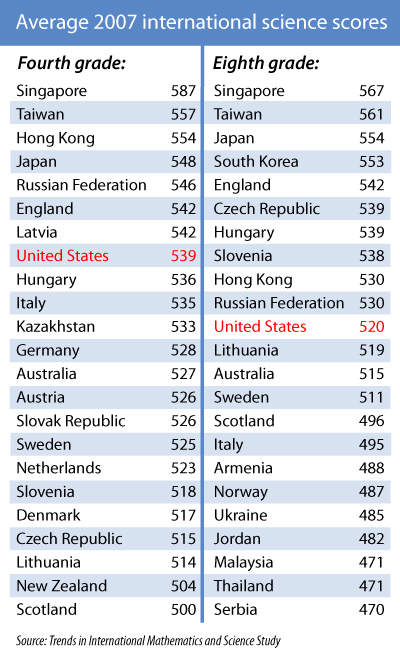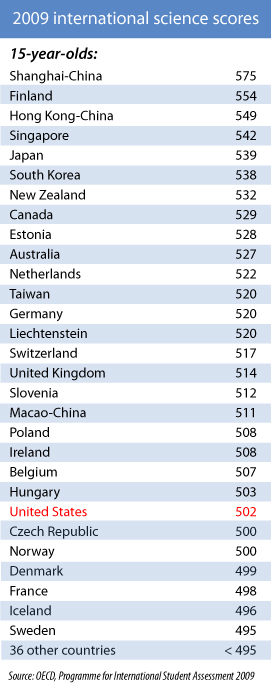JANUARY 26, 2011
By Sarah ButrymowiczStudents in the United States generally start to learn about the human eye in elementary school. Students in many other countries, though, don’t discuss the eye until eighth grade. At first glance, this difference would seem to indicate that our eight- and nine-year-olds are receiving an advanced science education compared to their peers elsewhere in the world.
But the disparity instead provides an apt analogy for the problems with the U.S. approach to science education, according to William Schmidt, a professor of education at Michigan State University.
 When our elementary school students learn about the eye, they typically memorize the different parts and leave it at that. Meanwhile, their peers in high-performing countries study the basics of atomic structure and photons. When they first turn their attention to the eye, in eighth grade, they know enough to understand how one sees and they study how photons of light are translated into electrochemical impulses.
When our elementary school students learn about the eye, they typically memorize the different parts and leave it at that. Meanwhile, their peers in high-performing countries study the basics of atomic structure and photons. When they first turn their attention to the eye, in eighth grade, they know enough to understand how one sees and they study how photons of light are translated into electrochemical impulses.American students memorize the facts while students in other nations learn the foundational concepts that make complicated processes understandable later on, Schmidt explained. In other words, they see. We don’t.
In 2007, the average U.S. fourth-grade science score was below those in Singapore, Taiwan, Hong Kong, and Japan, according to the Trends in International Mathematics and Science Study (TIMSS). And in eighth grade, U.S. students were outperformed by their peers in nine countries, including England, Hungary and the Czech Republic.
The downward trend continues after middle school. According to the 2009 Program for International Student Assessment (PISA) results, 15 year old students in the U.S. ranked below 20 countries, including Estonia, Finland and Korea, and two regions in China in science literacy. Shanghai, China came in first place, with their students averaging 73 points more than their American peers. In a 1997 TIMSS study that didn’t include Asian countries, U.S. students in their final year of high school ranked well below students in 11 other countries, including Sweden, Iceland and Canada, in general science knowledge.
Perhaps it’s no surprise, then, that by the time U.S. students get to college, interest in science is scant. In 2006, only 29.3 percent of first-year male college students intended to study a STEM field and just 15.1 percent of first-year females did. And even fewer actually complete these fields of study: out of over 1.5 million bachelor degrees awarded in 2007, only 16 percent were in STEM subjects.
The problems in our science education start early on and only get worse. At the root of it all is our approach to the content, experts say.
Finding the right sequence
By the time students in high-performing countries learn how the eye functions, they have enough background knowledge to comprehend the complicated process. This careful sequencing of topics is seen across the board in these countries – but it is conspicuously absent from most U.S. curricula.
For instance, the concept of plate tectonics is generally covered early in U.S. curricula. The topic is reserved for middle school in other countries. “In order to really understand what drives those plates, you need knowledge of physics and of the elements,” Schmidt said.
 Without the fundamentals, students can only gain superficial knowledge of a subject. In science, as in most subjects, building on top of foundational knowledge is key. “Where you start and how you get to a goal needs to be thought out,” both within a school year and across multiple years, said Richard Duschl, a professor in Penn State’s College of Education.
Without the fundamentals, students can only gain superficial knowledge of a subject. In science, as in most subjects, building on top of foundational knowledge is key. “Where you start and how you get to a goal needs to be thought out,” both within a school year and across multiple years, said Richard Duschl, a professor in Penn State’s College of Education.But U.S. curricula often ignore the research that demonstrates the importance of sequencing in science education. According to a 2005 study by Schmidt and others that analyzed curricula in high-performing countries as well as the U.S., science education in America starts in first grade, whereas most high-performing countries wait until third grade to teach science.
First-graders in America, according to the topics specified at each grade in the National Research Council’s National Science Education Standards, dive right into topics such as “organism sensing and responding” and the “dynamics of motion.” These topics are reserved for study in eighth grade by most high-performing countries, at a time when students have enough background knowledge to learn deeply about them.
‘A mile wide and an inch deep’
In the same study, Schmidt and his colleagues found that the U.S. not only lacks coherence in its standards, but it also advocates teaching far too many each year. The National Research Council’s standards recommend covering 29 out of 41 total topics in third grade. The majority of high-performing countries include only seven of these topics in their third-grade curricula.
Science education in the U.S. is frequently described as “a mile wide and an inch deep,” Duschl said. In an attempt to cover too many topics, none is taught or learned in sufficient depth, a problem that plagues both science and math education in America.
Textbooks only exacerbate the problem, Duschl said. Textbooks for each grade tend to contain dozens of topics, and, in many cases, they define the curriculum. In other countries, textbooks are not nearly as thick as they tend to be in the U.S., nor do they dictate the curriculum in the same way, according to Duschl.
When the subjects covered are too numerous to allow for the adequate study of any, the curriculum turns repetitive, Schmidt said. Students end up relearning the same sets of facts year after year, “rather than focusing on a small number of topics and doing them deeply and well.”
Demands of standards
By concentrating on a few subjects early on and building upon the fundamentals, students in higher-performing countries are able to take on a much more demanding curriculum by the time they reach middle school.
While many seventh- and eighth-graders in America may still be focusing on physical or earth science, “in the rest of the world, middle school science is really about physics and chemistry,” Schmidt said. “They’re moving into fairly serious science and the math to go with it.”
In 2003, only 46 percent of U.S. eighth-graders correctly answered a multiple-choice question about what a neutral atom becomes when it gains an electron (answer: an ion). In Singapore, by contrast, 79 percent of students answered this question correctly.
Even in cases where middle-school students take on the same topics worldwide, U.S. courses tend to be less rigorous in their demands for conceptual understanding. Often students in U.S. science classes are simply following a series of steps during their experiments. They aren’t being challenged to explain the scientific concepts behind the experiment.
“There’s sort of an assumption that at some point in the future they’ll get to science,” said Kathy Roth, director of the Biological Sciences Curriculum Study (BSCS) Center for Professional Development and a co-author of the study.
Meanwhile, teachers in high-achieving countries create a “science content story line,” Roth said. These teachers focus on the main idea of the lesson at the beginning of class and make clear connections to the activities. And lessons always end with a return to the original science concept being taught.
Although U.S. classrooms tend to feature more “fun” activities – such as using puzzles, games or stories – some high-performing countries like Japan still frequently engage students through activities. “An activity could be treated in a way when kids have to think hard before, during, and after the activity,” Roth said.

Nenhum comentário:
Postar um comentário